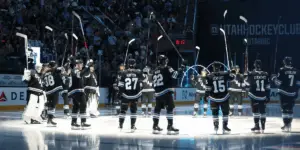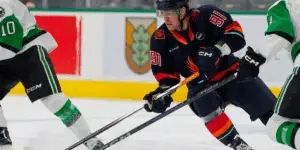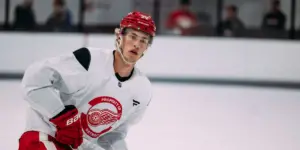
The New York Rangers are now on their 3rd coach in 4 years.
Needless to say, the Blueshirts have seen their fair share of coaching changes. The owner of the team, James Dolan, and the GM, Chris Drury, have cleaned the slate twice now with bench bosses since Drury took over the position from Jeff Gorton. The first move, replacing David Quinn with Gerard Gallant, seemed to be a case of overcorrection, going from a coach in Quinn – used to micromanaging players at the collegiate level – to a coach in Gallant who was seemingly too hands-off with his coaching style. After barely avoiding an early season meltdown (thanks only to Jacob Trouba and the helmet toss) and a first-round exit to Hudson Valley rivals, the New Jersey Devils, the Rangers opted to make a coaching change again.
Let’s take a look at Peter Laviolette’s NHL career and the people he’s surrounded himself with on the bench. Plus, a look into the system we can expect to see the Rangers use this season and what that could mean for the team.
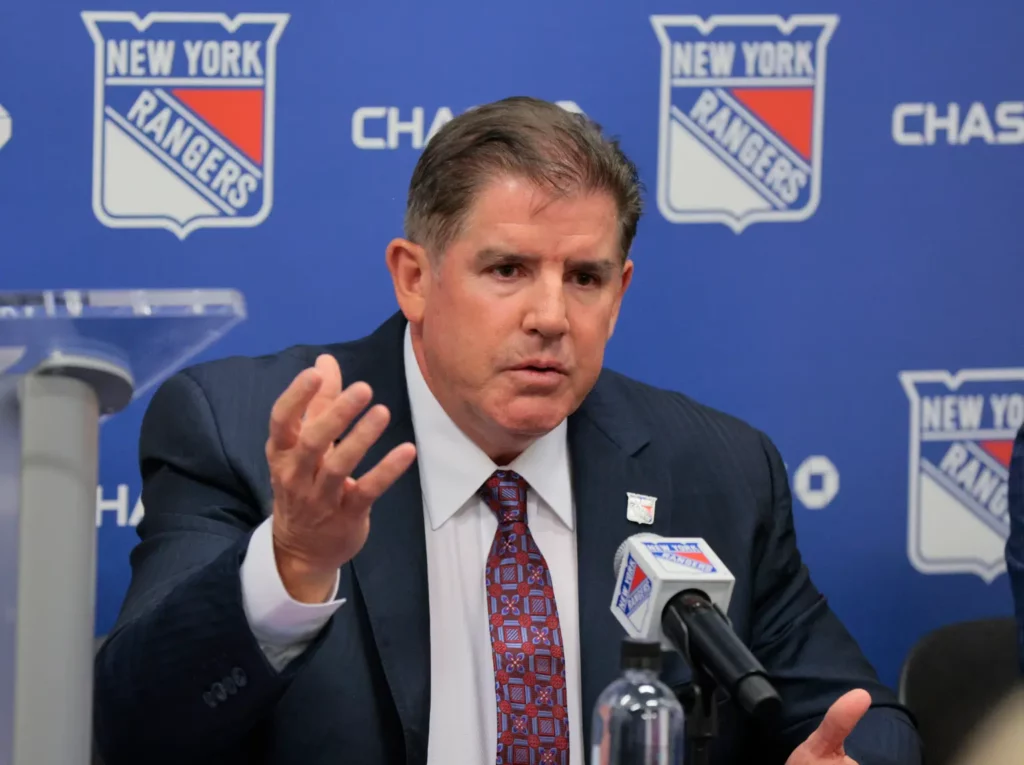
Peter Laviolette
NHL Background
Peter Laviolette’s career in the NHL spans back to the 1988-89 season, where he played the only 6 games of his career for…you guessed it…the New York Rangers. Coach registered 6 PIM and a +/- of +2 over that span. While his professional playing career might’ve been mostly limited to the AHL, Laviolette has been coaching in the NHL since the 2000-2001 season. In that time, Laviolette’s teams have made the playoffs 13 times, have made the finals three times (Hurricanes ’06, Flyers ’10, Predators ’17), and have won the Stanley Cup once (Carolina Hurricanes ’06). Coaching in the NHL for 23 consecutive seasons, with extensive playoff experience and a Cup win, speaks volumes about his experience and ability as a coach. However, this head coaching pick by the Rangers was initially met with criticism and contention.
The NHL is notorious for recycling the same few guys in head coaching positions, and some fans were hoping for a fresh new look. The worry is that older coaches like Laviolette are unable and unwilling to adapt to the new-age hockey style, and looking at other head coaches like Jared Bednar (Avalanche) and Jon Cooper (Lightning), some were hoping for an outside-of-the-box hire. Both these coaches are considered some of the best in the game, came from the AHL level after winning the AHL championship, and won Stanley Cups. The Rangers AHL affiliate, the Hartford Wolfpack, had what seemed to be a prime candidate in Chris Knoblauch after a successful 2022 campaign, but the Rangers management opted to go the safer veteran route by choosing Laviolette.
Laviolette and the Rangers management did, however, go with a coaching staff that boasts some extremely bright and newer-age minds that address specific needs for their roster.
Coaching Staff
What Rangers fans should really be excited about is the staff surrounding Laviolette. He brings in 3 coaches with whom he has prior coaching relationships: Hall of Fame Defenseman Phil Housley as his primary assistant, then Dan Muse and Michael Peca as his secondary assistants.
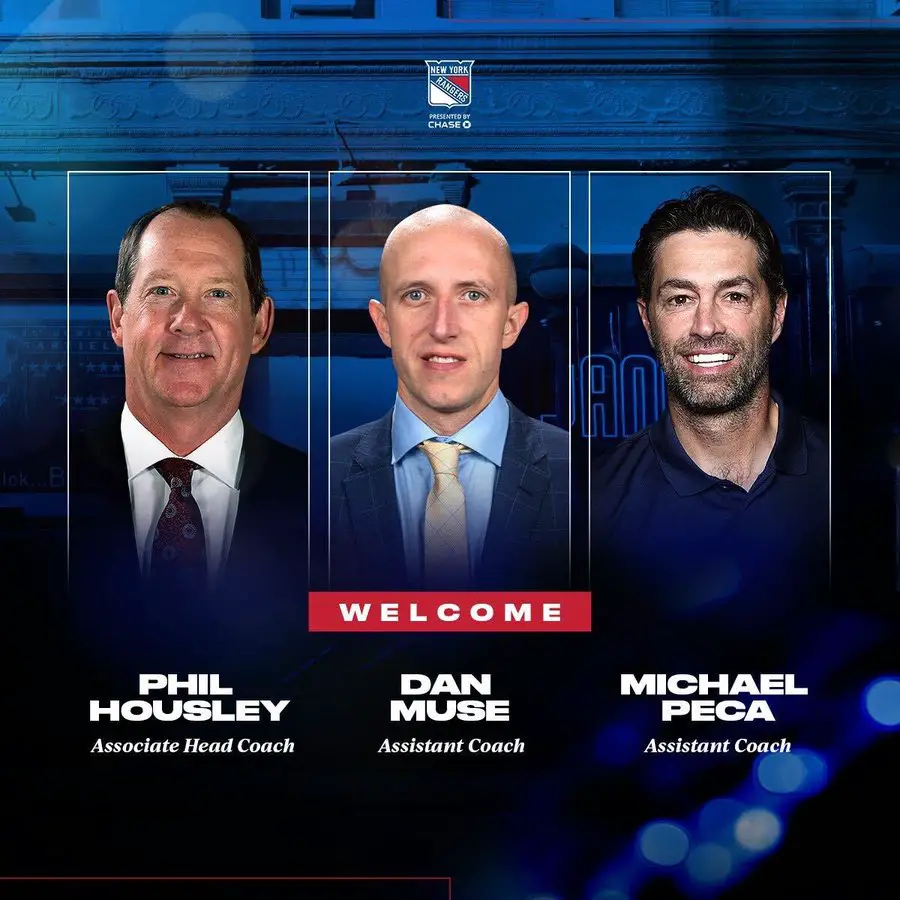
Phil Housley
Housley is second in points among American-born NHLers with 1,232, and – as a defenseman – one must wonder how Housley can make an impact with offensive-defenseman like Adam Fox and K’Andre Miller.
Dan Muse
Muse is an analytical hockey mind with experience head coaching the U.S. Under-18 Men’s team. He has ample experience with younger hockey professionals and was an early adopter of using data analytics to drive coaching decisions. It’s also likely that Muse will be running the PK this season, according to ex-Rangers netminder Steve Valiquette, via his podcast ‘The Garden Faithful’.
Michael Peca
Peca is young in the professional coaching game; he is a two-time Selke winner (the award given to the best two-way forward in the league), the former captain of the NY Islanders, and a face-off specialist. This is enticing to hear because the Rangers’ Centermen were tied for 20th in the league last season with a 49.1% Face-Off Win Percentage.
Laviolette and his three assistants should be a formidable group of hockey minds and provide the players with plenty of structure and hope to install a systematic play-style to the group with the ‘Left-Wing Lock’.
The ‘Left-Wing Lock’ System
There are two ways the ‘Left-Wing Lock’ system is used: in the offensive zone and in the neutral zone transitioning into the defensive zone. The system as a whole is a defensive-minded strategy meant for the forwards to support their D-men while the other team has the puck.
Offensive Zone
In the offensive zone, the ‘Left-Wing Lock’ is used as an overloading fore-checking strategy. It is used when your team does not possess the puck and is designed to overload the other team on their off-handed side. This system relies on the fact that a majority of players in the NHL are left-handed. If you can force the opposing team to break out of the zone up their off-handed (right) side, you should be able to overload those boards with more of your players on their forehands.
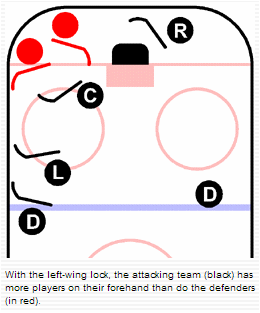
If the Rangers are the black circles above, the center (C) will cover the pass coming from the corner to the middle of the zone, the right wing (R) will cover the pass around the back of the net, and the left wing (L) will drop back and ‘lock’ up the breakout up the boards (supported by the Left D-man behind him).
Neutral Zone / Defensive Zone
If the opposing team gets a clean break out of their zone, the ‘Left-Wing Lock’ takes on a similar approach. The center and right-winger try to force the puck carrier to the left, and the left wing drops back again but this time in line with the other two defensemen. The white team is demonstrating this below:
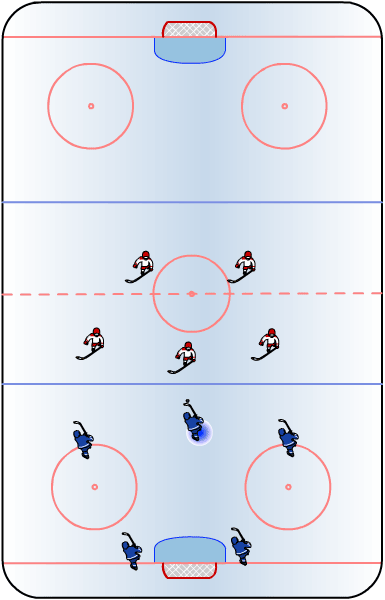
The left wing ‘locks’ up the defensive zone with the other defensemen, and this should ideally cut down on odd-man rushes since the left wing is taking on this defensive responsibility.
What this means for this Rangers roster:
The Rangers’ forward group has 5 righties: Zibanejad, Panarin, Trocheck, Wheeler, and Pitlick. It will be interesting to see how Laviolette constructs and shifts around line combinations to not overload too many righties on one line.
It is also a good idea to keep an eye on the left wings’ and the Defensemen’s positioning during these first few games to start the season. Kreider (1st line), Panarin (2nd line), Laf/Cuylle (3rd line), and Goodrow/Vesey (4th line) should be the ones dropping back and supporting their D. This, in turn, should allow for defensemen like Fox, Miller, and Gustafsson to feel more comfortable joining the rush since they should have back-up from the left winger.
Based on last season’s meltdown in the playoffs due to an overall lack of a hockey system, this type of structure should serve the Rangers well if they are able to adopt the positioning. What’s more likely is there are a few growing pains in learning a new system, and it makes sense that fans see some breakdowns in the ‘Left-Wing Lock’ plan early in the season. It also begs the question, does Laviolette expect Panarin to stay back and protect off the rush more? The Breadman is one of the most dynamic and dangerous players in the league when he attacks. How will it affect the offensive production of Panarin and the other left-wingers?
Answers soon.
Opening night: Thursday, 10/12.
Let’s Go Rangers.

A Key Day on Broadway – Ranting Rangers: A New York Rangers Podcast
Discover more from Inside The Rink
Subscribe to get the latest posts sent to your email.

